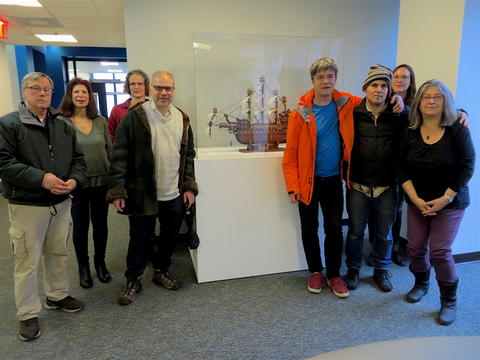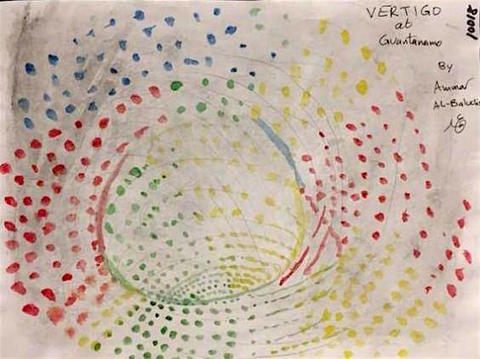The Guantánamo Art Show in New York That Dared to Show Prisoners As Human Beings— and the Pentagon’s Heavy-Handed Response

Close Guantánamo co-founder Andy Worthington at 'Ode to the Sea: Art from Guantánamo Bay' at the John Jay College of Criminal Justice in New York on January 17, 2018. The ship in the center of the photo was made by Moath al-Alwi, a Yemeni prisoner who is still held. Gathered around the exhibit are, from L to R: former Guantánamo military defense attorney Todd Pierce, Stephanie Locker from the World Can’t Wait, a visiting academic, blogger The Talking Dog, Andy, Jeremy Varon of Witness Against Torture, Erin Thompson and Debra Sweet, national director of the World Can't Wait.
If you can, please make a donation to support our work in 2018. If you can become a monthly sustainer, that will be particularly appreciated. Tick the box marked, "Make this a monthly donation," and insert the amount you wish to donate.
By Andy Worthington, February 16, 2018
Back in November, a disturbing story emerged from Guantánamo — of how a ten-year policy of allowing prisoners to give away art they have made at the prison to their lawyers and, via them, to family members had been stopped by the authorities, in response to an exhibition of prisoners’ artwork at the John Jay College of Criminal Justice, part of the City University of New York, which is known for its criminal justice, forensic science, forensic psychology, and public affairs programs.
The Pentagon had taken exception to an email address provided for people who were "interested in purchasing art" from the artists featured in the show. A Pentagon spokesman, Air Force Maj. Ben Sakrisson, said on November 15 that "all Guantánamo detainee art is 'property of the US government' and 'questions remain on where the money for the sales was going.'"
One problem with this position was that some of the art was by prisoners who are no longer at the prison,which surely raises questions about the extent of the Pentagon’s claimed "ownership" of their work, but the Department of Defense wasn’t interested in having that pointed out. Instead, a spokeswoman at the prison, Navy Cmdr. Anne Leanos, said in a statement that "transfers of detainee-made artwork have been suspended pending a policy review," and Ramzi Kassem, a professor at City University of New York School of Law whose legal clinic represents Guantánamo prisoners, said that one particular prisoner had been told that, if any prisoner were to be allowed to leave Guantánamo (which, crucially, has not happened under Donald Trump), "their art would not even be allowed out with them and would be incinerated instead."
This was outrageous, of course, because, as Carol Rosenberg, who broke the story, noted in the Miami Herald, the change in policy contravenes Federal Bureau of Prisons policy, which "lets its inmates mail 'arts and hobbycraft' to family, give them to certain visitors and sometimes display it in public space, if it meets the warden’s standard of taste."
However, as Andrea Prasow of Human Rights Watch stated in a powerful tweet, the development was "no surprise" because the "Pentagon has long claimed it owns detainees’ own memories of torture." As I noted in an article at the time, "She was referring in particular to the 'high-value detainees,' brought to the prison from CIA 'black sites' in September 2006, whose every word to their lawyers in the eleven years since has largely remained classified, but even for general prisoners, everything they say to their lawyers remains presumptively classified until the lawyers’ notes are reviewed by a Pentagon censorship team, which decides whether or not what the prisoners say can be made public."
It also strikes me that it is part of a fundamental problem with the "war on terror," whereby prisoners have been regarded as somehow exceptional — undeserving of the normal rights afforded to prisoners. Although the art program was triumphed by the military at Guantánamo for many years, with officials recognizing that it was good for the prisoners, and also good for the prison’s own blighted public relations, the sudden change of policy appears to be a return to the bad old days of hiding the prisoners away and keeping them silenced, which seems, moreover, to reflect a disconcerting clampdown on their status under Donald Trump.
My visit to 'Ode to the Sea: Art from Guantánamo Bay'
In January, during my annual visit to the U.S. to call for the closure of the prison on the anniversary of its opening, I visited the exhibition with a party of friends including Jeremy Varon of Witness Against Torture, and Debra Sweet of the World Can’t Wait, and was delighted to meet Erin Thompson, one of the curators of the show, whose eloquent and passionate defense of the prisoners’ work I had written about last year (see here and here). We had also exchanged messages on Twitter.
The show was powerful, but in a genuinely understated way. Some of the prisoners showed a real artistic talent; others less so. Of particular note was the work by Mohammed al-Ansi (aka Muhammad Ansi) and Djamel Ameziane, both released, and the elaborate sculptures of ships made of discarded materials by "forever prisoner" Moath al-Alwi, a Yemeni still held not because he has ever been accused of any significant involvement with terrorism, but because he has been a long-term hunger striker, and is not regarded as having been sufficiently cooperative. In a similar position is Khalid Qassim, who has produced interesting paintings through a variety of media.
Above all, however, the prisoners’ work, generally featuring uncontentious subject matter, did nothing more shocking than daring to show that they are human beings, with hopes and feelings and a comprehension of beauty and aesthetics. It was, therefore, genuinely shocking that the Pentagon had responded in such a heavy-handed manner to the show — and it was, of course, ironic that by doing so they had made the show considerably more popular than it would have been otherwise.
Erin Thompson told us that nearly a thousand people had been to see the show, which was open to the public, even though it was not a regular gallery, and was just a corridor, but of course the DoD’s intervention meant that a huge number of people heard about it via the mainstream media, on TV, in newspapers and online, like this CBS News feature, broadcast on January 21, in which Erin Thompson explained the prisoners’ attachment to the sea as follows: "The prison is only a few yards away from the sea, but they can't look at it. There are tarps covering all of the fences. Only once, when a hurricane was approaching, did the tarps come down. And they spent those days just looking at the ocean. And after the tarps went back up, they started to paint and sculpt ships, boats, ocean, just to recapture the feeling of peace from those days."
CBS News also spoke to the family of someone who died in the 9/11 attacks, who complained, "To have a public university sponsor this, I think is absolutely outrageous and reprehensible. We are now giving them a forum which they should not have. They should have no voice, because they snuffed out the voices of almost 3,000 people on September 11."

'Vertigo at Guantanamo' by Ammar al-Baluchi.
Unfortunately, the family missed the point, because only one of the eight men featured in the show has been accused of having any involvement with the 9/11 attacks — Ammar al-Baluchi, whose piece 'Vertigo at Guantanamo' was described by CBS News as "depict[ing] his experience of the brain injury he claims he suffered when he underwent so-called 'enhanced interrogation' (like waterboarding) by the CIA," and was "one of the most popular artworks" in the show. As Thompson said, to her it was "the most important work in the show." As she put it, "It's the most-clear link we have to the mind of someone capable of terrorism."
No one, whatever they are accused of, should be prevented from creating art, if they wish, but it’s also important to remember that the rest of the prisoners are not accused of having had any significant role in any kind of terrorist activity, and that four of them have been released, with just four still held, including al-Baluchi.
On January 24, six lawyers wrote to wrote to Secretary of Defense James Mattis, expressing "support of the long-established policy — which allowed for the release of art to detainees’ counsel, their families, and the public — as one that demonstrably benefits our detainee-clients, the detention authority, and the public at large."
An article for Hyperallergic further noted:
Protesting the ban on art leaving the base, the lawyers argue that the new regulations are counter-productive, as the art program has historically helped Guantánamo function more smoothly and made authorities’ jobs easier. "The benefits of art classes for prison populations, and for detaining authorities, have been widely researched and documented," they write. "For example, a literature review of studies on the topic found such benefits as greater emotional self-regulation and self-discipline. The validating effect of being seen through one’s own artwork can hardly be overstated. Thus, art programming has been positively correlated with improved inmate behavior." The letter further attests that the new policy is illegal under copyright law.
Bringing the story up to date
Bringing the story up to date, Carol Rosenberg confirmed for the Miami Herald last week that artwork by the prisoners, "once a proud fixture of media visits, has vanished from prison materials that reporters are allowed to see" following the change in policy.
Officials stated that the art program is ongoing, and prisoners are still making art, but Rosenberg pointed out that "a usual stop at a trailer where, for years, troops and contractors hung detainee drawings and paintings was excluded from a five-hour Detention Center Zone visit by U.S., Australian and Colombian reporters on Feb. 3." Rosenberg added, "It was the first media visit since summer, and the first since the Pentagon declared the art U.S. government property and halted a long-standing prison policy of letting captives give their artwork to their lawyers and families."
The prison’s cultural adviser, Zaki, told Rosenberg, "Detainees are still going to art class," although he acknowledged that the artists among the 41 remaining prisoners "were not happy about the change."
The prison’s commander, Rear Adm. Edward Cashman, also read out a statement about the authorities’ position. "I do not have the mission, the requirement, the direction or the capability to store every detainee art project forever," he said, adding, "I don’t have a project to build a detainee art museum. I do not have a project to hire a detainee art curator" — a not so subtle dig at Erin Thompson and her colleagues.
Asked whether it was true that prisoners’ art would be incinerated, he said that prisoners "voluntarily turn in 'completed projects' or those 'they’ve lost interest in' and the method of destruction was not incineration but having it 'shredded, thrown away if necessary.'"
Whether that is better than incarceration is open to discussion. However, what is abundantly clear, to anyone prepared to pay attention, is that the artists among the prisoners are profoundly unhappy about the policy change.
Shelby Sullivan-Bennis of Reprieve told Hyperallergic that her clients "were devastated to hear that their art couldn’t leave the prison. For some, that was its express purpose. For others, they realized the importance of its outside recognition only once it was taken away. Of my three clients, only one continues to attend art class, and it’s intermittently." On my U.S. visit, I was also told that, until the recent clampdown, Moath al-Alwi had been making his ships on a full-time basis, but that he too has had this outlet for his creativity savagely curtailed.
Sullivan-Bennis added, "My understanding is that the attendance of the class and production of art has all but ceased."




